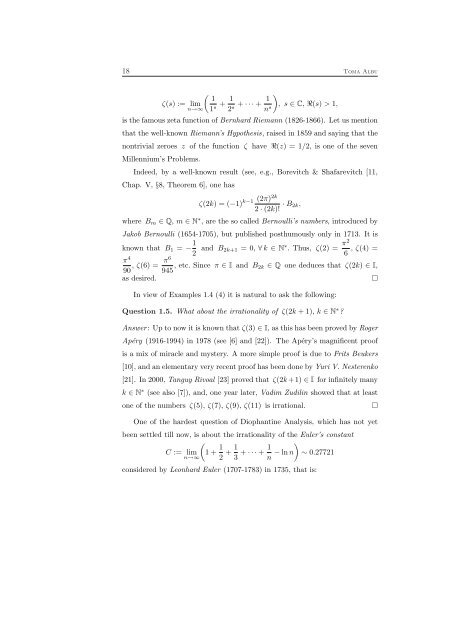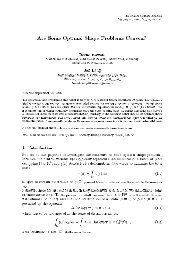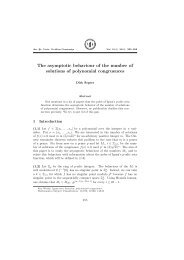the irrationality of sums of radicals via cogalois theory
the irrationality of sums of radicals via cogalois theory
the irrationality of sums of radicals via cogalois theory
- No tags were found...
You also want an ePaper? Increase the reach of your titles
YUMPU automatically turns print PDFs into web optimized ePapers that Google loves.
18 Toma Albu( 1ζ(s) := limn→∞ 1 s + 1 2 s + · · · + 1 )n s , s ∈ C, R(s) > 1,is <strong>the</strong> famous zeta function <strong>of</strong> Bernhard Riemann (1826-1866). Let us mentionthat <strong>the</strong> well-known Riemann’s Hypo<strong>the</strong>sis, raised in 1859 and saying that <strong>the</strong>nontri<strong>via</strong>l zeroes z <strong>of</strong> <strong>the</strong> function ζ have R(z) = 1/2, is one <strong>of</strong> <strong>the</strong> sevenMillennium’s Problems.Indeed, by a well-known result (see, e.g., Borevitch & Shafarevitch [11,Chap. V, §8, Theorem 6], one hask−1 (2π)2kζ(2k) = (−1)2 · (2k)! · B 2k,where B m ∈ Q, m ∈ N ∗ , are <strong>the</strong> so called Bernoulli’s numbers, introduced byJakob Bernoulli (1654-1705), but published posthumously only in 1713. It isknown that B 1 = − 1 2 and B 2k+1 = 0, ∀ k ∈ N ∗ . Thus, ζ(2) = π26 , ζ(4) =π 4π6, ζ(6) =90 945 , etc. Since π ∈ I and B 2k ∈ Q one deduces that ζ(2k) ∈ I,as desired.□In view <strong>of</strong> Examples 1.4 (4) it is natural to ask <strong>the</strong> following:Question 1.5. What about <strong>the</strong> <strong>irrationality</strong> <strong>of</strong> ζ(2k + 1), k ∈ N ∗ ?Answer: Up to now it is known that ζ(3) ∈ I, as this has been proved by RogerApéry (1916-1994) in 1978 (see [6] and [22]). The Apéry’s magnificent pro<strong>of</strong>is a mix <strong>of</strong> miracle and mystery. A more simple pro<strong>of</strong> is due to Frits Beukers[10], and an elementary very recent pro<strong>of</strong> has been done by Yuri V. Nesterenko[21]. In 2000, Tanguy Rivoal [23] proved that ζ(2k +1) ∈ I for infinitely manyk ∈ N ∗ (see also [7]), and, one year later, Vadim Zudilin showed that at leastone <strong>of</strong> <strong>the</strong> numbers ζ(5), ζ(7), ζ(9), ζ(11) is irrational.One <strong>of</strong> <strong>the</strong> hardest question <strong>of</strong> Diophantine Analysis, which has not yetbeen settled till now, is about <strong>the</strong> <strong>irrationality</strong> <strong>of</strong> <strong>the</strong> Euler’s constantC := lim(1 + 1n→∞ 2 + 1 3 + · · · + 1 )n − ln n ∼ 0.27721considered by Leonhard Euler (1707-1783) in 1735, that is:□






